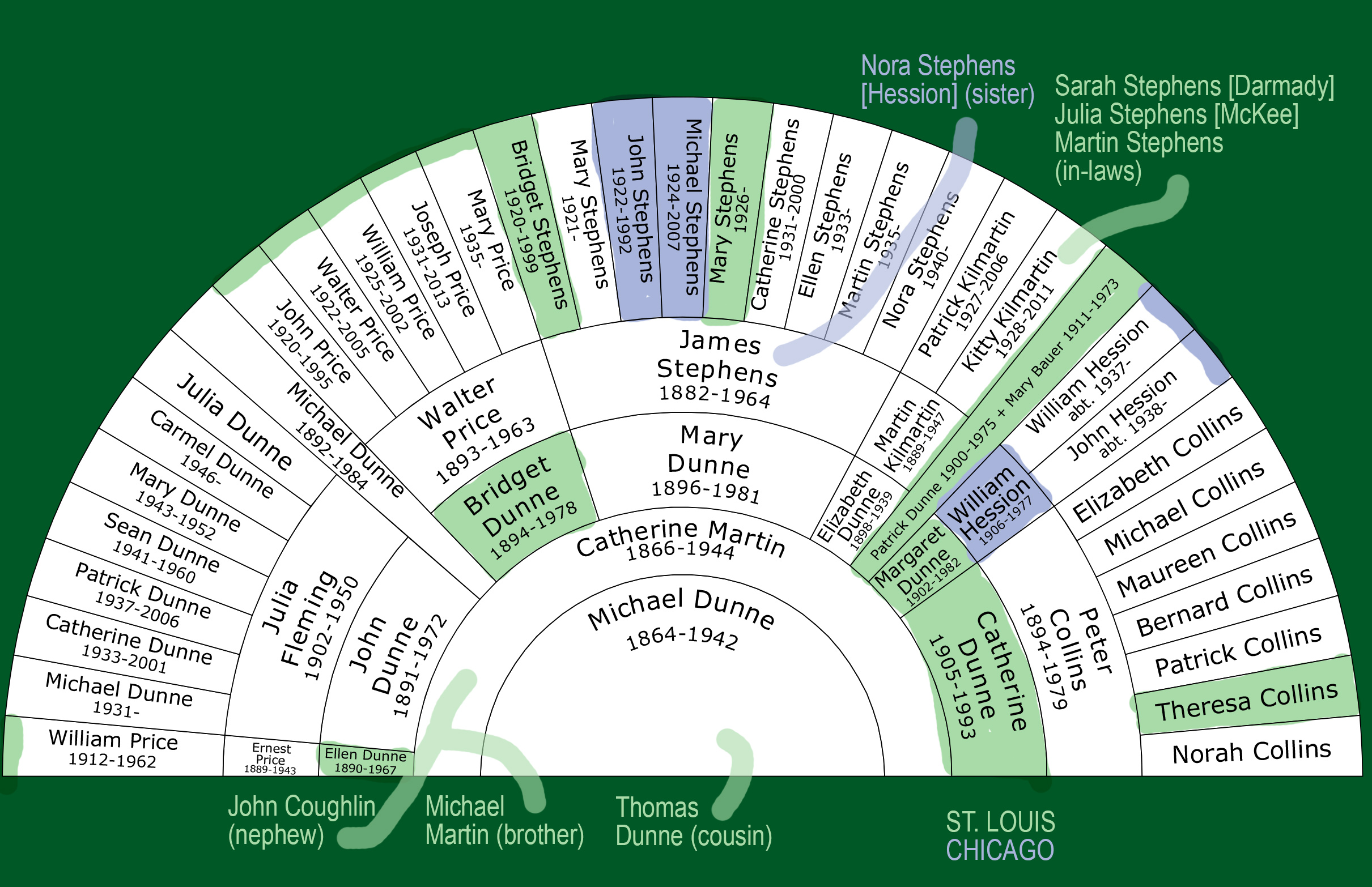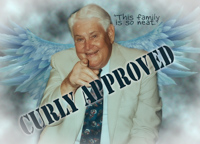Mad in Pursuit Notebook

Dunne Family Connection to St. Louis
Cora asks: How did the Dunnes end up in St. Louis? Did they come via Ellis island? Why St. Louis? Were they all Catholic... and did we influence Catholics in St. Louis?
How my family wound up in St. Louis (as opposed to somewhere more "glamorous" like New York or Boston) has always been one of my favorite questions. Not sure I have the perfect answer, but here are some generalities and some specifics.
 ☘️ St. Louis, Missouri, was settled early on by Irish, even before the great waves of famine refugees in the late 1840s. It prospered because of its location on the Mississippi River, with steamboat trade down to New Orleans, and was a jumping off point for westward expansion. There was always work for laborers.
☘️ St. Louis, Missouri, was settled early on by Irish, even before the great waves of famine refugees in the late 1840s. It prospered because of its location on the Mississippi River, with steamboat trade down to New Orleans, and was a jumping off point for westward expansion. There was always work for laborers.
☘️ Irish-Catholic institution-builders. Because there were so many Catholics among waves of immigrants to St. Louis and because the Irish were great organizers (and spoke English), they took the lead in forming 29 parishes in the City [1]. Neighborhoods were defined by parish boundaries. Apparently only in St. Louis, the first question a stranger asks you is "What parish are you from?"
Catholic schools dominated education. Catholic hospitals dominated healthcare. Catholic nuns ran all these systems.
☘️ Irish domestic work. As St. Louis industries expanded, the rich shoe and beer barons were always looking for domestic help. They preferred Irish girls. Why? The Irish were white. They spoke English. And once you found one you liked, she always had sisters or nieces to take her place when she married.
So, for example, in the Dunne family, sisters Ellen (aka Helen, b. 1890), Bridget (b. 1894), Maggie (b. 1902), and Katie (b. 1905) all migrated specifically to work as domestics.
Katie found work with the International Shoe heiress Mrs. Minnie Johnson in the 1920s [2]. Mrs. Johnson then also hired Maggie. The 1930 U.S. census shows the two sisters working together. After Katie returned to Ireland and Maggie got married, Johnson hired Mary Dunne Stephens' daughters Vera ( b. 1920) and Mary Teresa (b. 1926), then Katie's daughter Theresa Collins (b. 1932). The story goes that Johnson paid the passage for the three younger girls, but took the cost out of their wages.
☘️ The Irish economy and chain migration. The Dunnes and their neighbors were not as hard hit by the potato famine as others, so they were able to hang on to their land and postpone emigration till it was less a matter of survival and more about smart economics. (Plus, I read the women couldn't find enough men to marry.)
Ships' manifests from the early 20th century are filled with folks from northeastern Galway, headed for family members in NYC, Boston, Chicago, and St. Louis. They practiced "chain migration," going to communities where they knew family and where there were jobs.
My question is "which brave soul came first?" Unfortunately, the earlier ship records didn't list towns of origin, much less sponsor information.
Who is "Immigrant Zero" in our family?
☘️ As of today, the earliest Ballaghduff/Rushestown émigré I can find is Aunt Delia Martin (my great-great aunt) of Rushestown, my great-grandmother's youngest sister.
In April, 1895, she arrived on the Pavonia with what appears to be a group of emigrants from her area. The ship's record states her destination as Boston, where her brother Patrick and his wife were expecting their third child. Another brother, Peter, lived in Ohio. Why did she move to St. Louis? What family or friend invited her there?
Maybe it had to do with the 1896 arrival in St. Louis of Thomas Dunne, her Rushestown neighbor and possible cousin to her brother-in-law Michael Dunne. They married in 1907. (And what or who drew him to St. Louis, when he had immigrant family already in Ohio? See note [4] below.)
☘️ Sarah Marie Stephens arrived on the Lucania a month later and became a domestic for the Hoyt family [3] in St. Louis, till she married Martin Darmady in 1901. Sarah had two children. Her son became a priest. Her daughter married into the Wever family.
In 1906, Sarah sponsored her younger siblings, Julia Stephens (age 20) and Martin Stephens (age 18). Julia got married to Thomas McKee soon after her arrival so might have avoided domestic service. "Mrs. McKee" was a household name in our family because she ran the catering function for the posh St. Louis Women's Club. My grandmother Bridget worked for her, making delicate cucumber sandwiches and other delights, till she was at least 80 years old. Julia's daughter and two sons all joined religious orders.
These three Stephenses were the children of Ballaghduff residents Patrick Stephens (1835-1912) and Kitty Crowe (1846-1913). (Their grandson Peter married into the Dunne family. His wife was Kitty Kilmartin and daughter is Maura Stephens [Arnold].)
☘️ In 1907, Michael Martin (our great-grandmother Catherine Martin's brother, b. 1870, age 37) and his niece Ellen Dunne (age 17) emigrated to St. Louis. They were sponsored by Thomas Dunne (1871-1944), newly wed to Martin's sister/Ellen's aunt Delia (see above). [4]
A Chicago sidenote: On the same ship as Uncle Mike and Ellen was Nora Stephens, sister-in-law to Mary Dunne Stephens. She started out in NYC but wound up in Chicago and married into the Hession family from Ballyglunin, not far from Ballaghduff. In 1929, she sponsored her nephew Bill Hession, who married our aunt Maggie Dunne. Nora was also responsible for bringing Jack and Mike Stephens to Chicago in the late 1940s, where there was apparently more work at the time for laborers.
☘️ Meanwhile, back in St. Louis, in 1914, Ellen Dunne (now "Helen" Price) sponsored the passage of her sister Bridget Dunne. Then, in 1938, she sponsored her brother Patrick Dunne (b. 1900) and their Martin-side cousin John Coughlin (b. 1899).
I guess the short answer to the question "why St. Louis" is that once the Dunne family had linked into a community, it was easy to settle there—people who knew your people, knew you. Chain migration—chains of love.
LIST of immigrants by year of arrival
All from Kilkerrin area to St. Louis, unless stated otherwise. I'm adding a few others not included above, as I find them.
1895. Sarah Marie Stephens [Darmady] (1879-1952), Delia Martin [Dunne] (1874-1943)
1896. Thomas Dunne (1871-1944) from Rushestown
1906. Julia Stephens [McKee] (1885-1966) and Martin Stephens (1888-1985)
1907. Michael Martin (1870-1961) from Rushestown, Ellen Dunne [Price] (1890-1967). And Nora Stephens [Hession] (1889-1965) to NYC, then Chicago.
1914. Bridget Dunne [Price] (1894-1978)
1923. Katie Dunne [Collins] (1905-1993). Returned to Ireland in the early 1930s.
1927. Maggie Dunne [Hession] (1902-1982)
1929. Bill Hession (1906-1977), to Chicago (and got Maggie Dunne to move there with him)
1938. Patrick Dunne (1900-1975) from Ballaghduff/Cooloo and John Coughlin (1899-1968) from near Ballygar
1939. Catherine (aka Kathleen) Stephens [Ryan] (1918-1999) (Maura's paternal aunt, sponsored by "cousin Mrs. Oates" on Terry Av, also heading to a job as a domestic)
1939. Vera (Bridget Veronica) Stephens [Whelan] (1920-1999)
????. Mary Teresa Stephens [Barry] (1926- )
????. Nellie Stephens [Glynn] (1929-1971) (Maura's paternal aunt, sister of Catherine Stephens above)
1949. Theresa Collins [Davis] (1932- )
1949. Jack Stephens, to Chicago (1922-1992)
194?. Mike Stephens, to Chicago (1925-2007)
Notes
[1] David A. Lossos. Irish in St. Louis. Acadia Publishing, 2004.
[2] MRS. JOHNSON (b. 1870) of 25 Portland Place. Her husband was Jackson Johnson, co-founder, president, and chairman of International Shoe Co., once the largest shoe company in the world. They were from Mississippi and she was an active member in the United Daughters of the Confederacy.
[3] The Hoyts were connected to Hoyt Metals in Granite City. The company was bought out by National Lead in the late 1920s. Coincidentally, my dad had his career with National Lead, as a sales rep for Dutch Boy Paint.
[4] Thomas Dunne's father was Thomas Dunne, Sr. (abt. 1825-abt. 1911), a neighbor to the Martins in Rushestown and possibly related to the Ballaghduff Dunnes. In the mid-19th century, three of Dunne Sr.'s siblings migrated to the Wakefield, Ohio, area. His son Matt acquired a home in Cooloo at the same time the Ballaghduff Dunnes did. So the families definitely knew each other.
4 Mar 2018 (rev. 20 Mar 2018, 17 Mar 2025)

All pages in this website by Susan Barrett Price are licensed under a Creative Commons Attribution-Noncommercial-Share Alike 3.0 United States License.